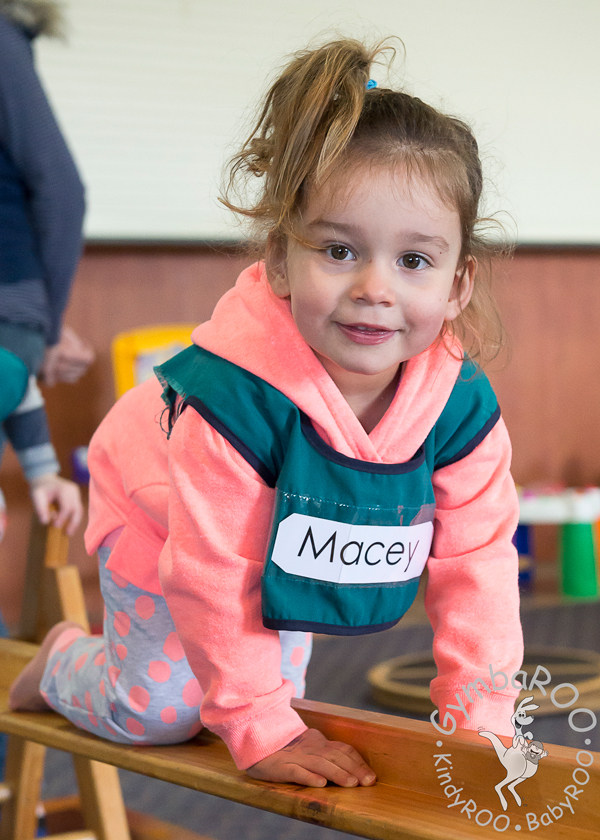Join the thousands of parents already raising smarter, happier babies with our online baby classes: The Active Babies Smart Kids series. Click here.
GymbaROO-KindyROO kids are excelling academically, emotionally, in leadership roles and on the sporting field. Find us at: GymbaROO-KindyROO
Dr Jane Williams and Bindy Cummings
Identifying ‘Just Noticeable Differences’ for Optimal Learning Readiness
Children who have in place the essential neurological foundations for optimal development do not display Just Noticeable Differences (JNDs). JNDs are the ‘little developmental hiccups’ that usually do not warrant medical intervention or a complete developmental assessment, but may cause behaviour or learning challenges once a child heads off to school.
Everyone expects their children to learn once they get to school – and may blame the teachers if they do not. Yet many children enter school without the skills required for learning and so learning is a real struggle. It is therefore imperative that any JNDs be identified before school age and appropriate preventative care be implemented.
JNDs may not be cause for medical concern but they can make the difference between just coping or really enjoying academic success. So, rather than wait and hope a child will grow out of it, it’s important to recognise they exist, that they have an impact on later learning and that there is lots that can be done to correct them before a child reaches school age. It is more than likely that children with JNDs are extremely intelligent… it’s just that these developmental hiccups hold them back.
What causes JNDs?
JNDs can arise from numerous causes and certain experiences will increase a child’s risk of JNDs. For example, a premature birth, or a long, difficult birth that causes the baby some form of distress; exposure to extremely high levels of stress; lack of early sensory-motor opportunities; chronic illnesses, amongst other things, may predispose a child to JNDs. Most of these are out of parents’ control and even though most parents work hard to do the very best for their baby and child the JNDs still arise. Sometimes there is no known explanation for the occurrence of JNDs.
The good news is that GymbaROO and KindyROO centres are staffed by qualified personnel who are aware of these JNDs and can offer appropriate corrective activities or suggest other professional help.
What to look for
In the past it was rare for anyone to pay attention to JNDs before a child reached school and began to struggle, but today we know more, we know what to look for and we know what to do.
JNDs in babies
- Fidgety or general movements (between weeks six and twelve) are weaker or stronger than expected. This may reflect muscle tone that is lower or higher than expected.1.
- Head lifting and pushing up on arms is delayed.
- Does not like tummy time. Free GymbaROO tummy time video and tips here.
- Bottom shuffles, bear walks, rolls everywhere, does not crawl or creep, or creeps in a pattern other than the cross-pattern creeping on hands and knees. More here.
- Always unhappy.
- Has difficulty feeding.
- Has recurring ear infections.
- Not babbling.
JNDs in 12 months to 2½ years
- Cries frequently, unsettled.
- Slow to gain good balance walking and not running by 18 months.
- Does not have a strong grasp – can’t hold body weight by hands on the trapeze or when tick-tocking holding onto parent.
- Dislikes spinning.
- Hyperactive.
- Sensory timidity – dislikes massage, noise, bright lights, lumpy foods etc.
- Poor balance, muscle tone and coordination.
- Can’t jump with both feet off the ground by 2 ¼ .
- Behaviour abnormal – tantrums at this age are normal, but not all the time!
JNDs in 2½ to 3½ years
- Unable to ride a trike by three years of age.
- Unable to cross over the midline in exercises.
- Standing on one foot is impossible.
- Slow speech – hard to understand.
- Has difficulty following instructions.
- Poor muscle tone and coordination.
- Difficulty moving own limbs with rhythm.
- Obviously slower than their peers.
- Still clinging to parent for safety.
JNDs in 3½ years to 4½ years
- Motor skills delay – not cross patterned in movement, can’t skip along, kick a stationary ball.
- Drawing immature – not yet representational.
- No preferred hand/side.
- Cannot do cross pattern progression across the overhead.
- Unable to cross midline physically or visually.
- Poor finger awareness – by this age a child should know pointer, the thumb and usually ‘pinky’!
JNDs in 4½ years to 5½ years
- Developmental delay in movement skills and concentration.
- Hyperactivity – unsettled behaviour.
- Changes hands at the midline.
- Does not know left or right side.
- Cannot gallop or skip.
- Does not draw a person with head, body, limbs and facial features.
- Visual tracking and other visual problems.
- Hearing/speech difficulties.
- Read more: School readiness: Is my child ready for school? A checklist
If you have concerns about any of the above, please ask your GymbaROO or KindyROO teacher and/or your local health professional for advice. Your concerns should be taken seriously. If you are ‘brushed off’ and told you are being over-concerned, consider seeking a second opinion. You are a child’s most important advocate as you spend more time with your child than anyone else. If you have a concern it is legitimate and important.
At GymbaROO-KindyROO we have a raft of activity ideas that you can put in place at home to assist your baby and child’s development so that JNDs are overcome. The sooner attention is drawn to your concerns, the earlier something can be done about it. This is important as the brains of very young children respond very quickly to the intervention. The older a child gets, the longer it takes for change to occur. Post continues after image.
So don’t worry if your child is displaying some of the above JNDs, there are solutions to all of them. We may also connect you to key health professionals as a child will likely benefit from their services as well. At GymbaROO-KindyROO the most important part of our job is to help your children become successful and happy learners at school.
 Dr Jane Williams (PhD, BMgt, RN(Paeds)) is the Research and Education General Manager for GymbaROO and KindyROO. Dr Williams is one of Australia’s leading experts on baby and child development. More on Dr Williams here.
Dr Jane Williams (PhD, BMgt, RN(Paeds)) is the Research and Education General Manager for GymbaROO and KindyROO. Dr Williams is one of Australia’s leading experts on baby and child development. More on Dr Williams here.
Bindy Cummings (B.Ed(Human Movement) Hons) has worked as a teacher, child development consultant, early childhood development lecturer, teacher trainer and INPP & iLS consultant. She is the co-creator of GymbaROO’s Active Babies Smart Kids online series, has authored many published articles on child development. She is working on the content and development GymbaROO’s portal and online training programs, and the creation of new online programs for parents and children. More on Bindy Cummings here.
-
Pretchl, H.F.R. (2001). General movement assessment as a method of developmental neurology: new paradigms and their consequences. Developmental Medicine & Child Neurology, 43 (12), 836-842.
GymbaROO Images by Studio Z Photography
GymbaROO-KindyROO
Thousands of parents, babies and children are presently involved in our programs and creating rising stars. GymbaROO-KindyROO kids are excelling academically, emotionally, in leadership roles and on the sporting field. Come join all the fun and learning! “GymbaROO – The best decision I ever made for my child.” Classes from 6 weeks old – 7 years GymbaROO KindyROO
Active Babies Smart Kids – Online Baby Classes
GymbaROO-KindyROO’s online series of baby classes is taking the parenting world by storm! It is highly recommended by doctors, paediatricians, early childhood experts and the Maternal Child and Family Health Nurses Association. This series is being called: “The essential guide for parents”. Join the thousands of parents already playing with their babies from birth, in the best way for brain and body development and laying crucial foundations for future learning. What happens in the first year, not only matters, it matters a lot! See Introductory video below.
Active Babies Smart Kids online series – Click here.
Try the first class FREE! Click here to watch our Active Babies Smart Kids Episode 1 – Tummy Time
Enjoy the following GymbaROO-KindyROO articles
GymbaROO-KindyROO: Who, what, where, why and how
All about GymbaROO-KindyROO’s online baby classes for parents and babies: Active Babies Smart Kids
How to raise a smarter, happier baby
Why active babies make smart kids
Become a GymbaROO-KindyROO franchisee
School Readiness: Is my child ready for school? A checklist
Tummy time for baby’s healthy development.
NAPLAN results improve with LESS reading and maths and MORE GymbaROO.
‘Baby Seat’ devices and propping your baby to sit. Please avoid. This is why.
Why creeping and crawling matter.
Baby milestones: A journey, not a race.
Terrifically toned: Muscle tone and its link to learning and development in babies and children.

